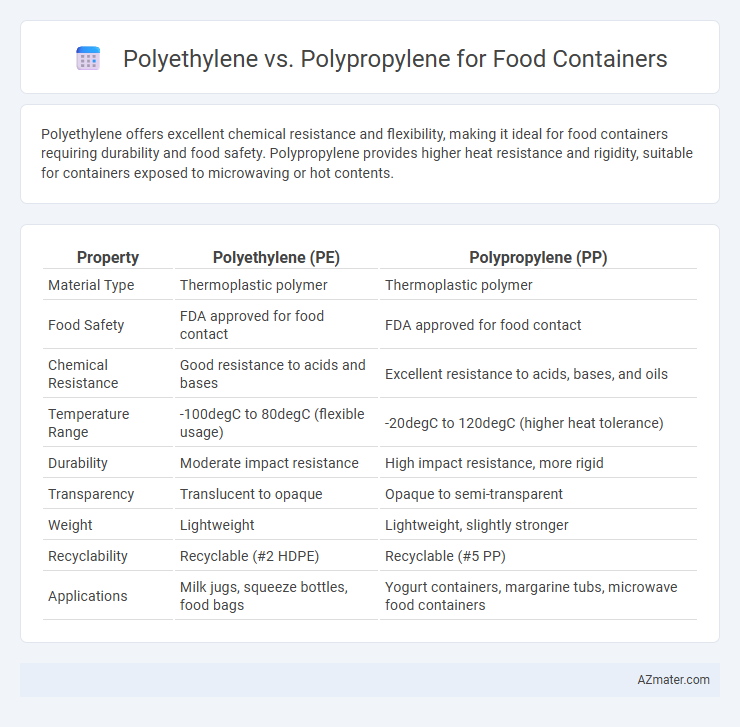Polyethylene offers excellent chemical resistance and flexibility, making it ideal for food containers requiring durability and food safety. Polypropylene provides higher heat resistance and rigidity, suitable for containers exposed to microwaving or hot contents.
Table of Comparison
| Property | Polyethylene (PE) | Polypropylene (PP) |
|---|---|---|
| Material Type | Thermoplastic polymer | Thermoplastic polymer |
| Food Safety | FDA approved for food contact | FDA approved for food contact |
| Chemical Resistance | Good resistance to acids and bases | Excellent resistance to acids, bases, and oils |
| Temperature Range | -100degC to 80degC (flexible usage) | -20degC to 120degC (higher heat tolerance) |
| Durability | Moderate impact resistance | High impact resistance, more rigid |
| Transparency | Translucent to opaque | Opaque to semi-transparent |
| Weight | Lightweight | Lightweight, slightly stronger |
| Recyclability | Recyclable (#2 HDPE) | Recyclable (#5 PP) |
| Applications | Milk jugs, squeeze bottles, food bags | Yogurt containers, margarine tubs, microwave food containers |
Introduction to Polyethylene and Polypropylene
Polyethylene and polypropylene are widely used plastics in food container production due to their durability and safety. Polyethylene, known for its flexibility and chemical resistance, is often chosen for its excellent moisture barrier properties, making it ideal for perishable food storage. Polypropylene offers higher heat resistance and rigidity, allowing it to withstand microwave heating and repeated use without deforming.
Chemical Structure and Composition
Polyethylene (PE) consists of long chains of ethylene monomers with a simple, non-polar hydrocarbon structure, providing flexibility and chemical resistance ideal for food containers. Polypropylene (PP) is made from propylene monomers, featuring a methyl group attached to its carbon backbone, which impart greater rigidity and higher melting points compared to polyethylene. The chemical structure differences result in PP offering better resistance to heat and fatigue, while PE excels in clarity and impact resistance for various food packaging applications.
Manufacturing Processes
Polyethylene (PE) and polypropylene (PP) are widely used polymers in food container manufacturing due to their distinct processing advantages. Polyethylene is typically processed through extrusion and blow molding, offering excellent flexibility and moisture resistance, while polypropylene is favored for injection molding and thermoforming thanks to its higher melting point and rigidity. These manufacturing processes influence the containers' durability, heat resistance, and suitability for various food storage applications.
Physical Properties Comparison
Polyethylene and polypropylene differ notably in their physical properties, influencing their suitability for food containers. Polyethylene offers greater flexibility and impact resistance, making it ideal for squeeze bottles and wrap films, while polypropylene provides higher rigidity and a higher melting point, suitable for microwave-safe containers. Both materials are food-safe, but polypropylene's superior chemical resistance and structural strength make it preferable for durable, reusable containers.
Thermal Resistance and Temperature Tolerance
Polypropylene (PP) exhibits superior thermal resistance compared to polyethylene (PE), withstanding temperatures up to 160degC, making it ideal for hot food storage and microwave use. Polyethylene, particularly high-density polyethylene (HDPE), tolerates temperatures around 120degC but tends to soften and deform at higher heat levels. The choice between these polymers hinges on the need for higher temperature tolerance and durability, with PP offering better performance for applications requiring repeated heating.
Food Safety and Regulatory Approvals
Polyethylene (PE) and Polypropylene (PP) are widely used materials in food containers, both approved by the FDA for food contact due to their non-toxic and BPA-free nature. Polypropylene offers higher heat resistance, making it suitable for microwave-safe containers, while polyethylene is known for its excellent moisture barrier properties. Both materials comply with EU Regulation No 10/2011 and FDA 21 CFR 177 standards, ensuring they meet stringent food safety and migration limits for packaging materials.
Durability and Lifespan in Food Containers
Polyethylene offers excellent impact resistance and flexibility, making it highly durable for food containers that require frequent handling and cold storage. Polypropylene provides superior heat resistance and chemical stability, extending the lifespan of containers used for hot foods and microwave applications. Both polymers maintain food safety standards, but polypropylene generally outlasts polyethylene in high-temperature environments due to its higher melting point.
Environmental Impact and Recyclability
Polyethylene (PE) and polypropylene (PP) differ significantly in environmental impact and recyclability; PE, commonly used in food containers, is easier to recycle due to widespread recycling programs but has a higher carbon footprint during production. PP offers greater chemical resistance and higher heat tolerance, making it suitable for reusable food containers, with recycling codes 5 that indicate moderate recyclability but fewer recycling facilities accept PP compared to PE. Both plastics contribute to plastic pollution if not properly managed, but advancements in chemical recycling and bioplastics aim to reduce the environmental burden of PE and PP food containers.
Cost Comparison for Manufacturers and Consumers
Polyethylene generally costs less than polypropylene, making it a more budget-friendly choice for food container manufacturers aiming to minimize production expenses. Consumers benefit from polyethylene containers with lower retail prices, though polypropylene offers better heat resistance, which can justify its higher cost. Manufacturers must balance the upfront material cost against performance requirements, while consumers consider affordability and container durability in their purchasing decisions.
Choosing the Best Material for Food Storage
Polyethylene and polypropylene are popular choices for food containers due to their durability and safety. Polyethylene offers excellent flexibility and resistance to moisture, making it ideal for storing liquids and perishable items. Polypropylene stands out for its higher temperature resistance and rigidity, which is better suited for microwave-safe containers and long-term food storage solutions.

Infographic: Polyethylene vs Polypropylene for Food Container
 azmater.com
azmater.com